-
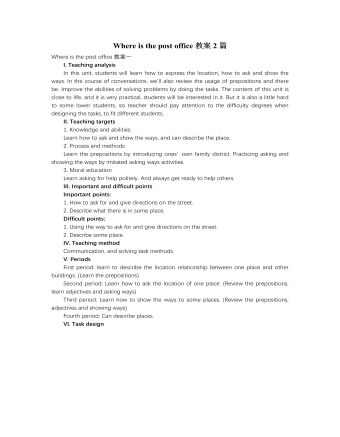
人教版新目标初中英语七年级下册Where is the post office教案2篇
Period 2 (3a----Section B 2c)Preview(Pre-task): Key points: What laAdd another information about their pen pals----their language on the cardnguage does she/he speak?She/He speaks....Does she/he have any brothers and sisters? Does she/he speak English?Preview(Pre-task): Add another information about their pen pals----their language on the cardKey points: What language does she/he speak?She/He speaks....Does she/he have any brothers and sisters? Does she/he speak English?Step 1 Revision1.Revisionand dictation of the new words 2.Revise the drills they learned yesterday.(by pairwork and grammar exercise)Step 2 Leading-inT has a conversation with one student. The conversation is following:---Do you have a pen pal?---Yes, I do.---What's your pen pal's name? ---His/Her name is....---Where is your pen pal from? ---He/She is from...---Where does he/she live? ---He/She lives in....---What language does he/she speak?He/She speaks...Write the new words on the Bb. They are following: EnglishChineseJapaneseFrenchStep 3 LearnLearn the new words with the whole class.Finish 3a with the students3b Pairwork T still does an example with one student Then the Ss practise in pairs. The example is following:--Curry Muray is my pen pal. He is from the United States.---What language does he speak?
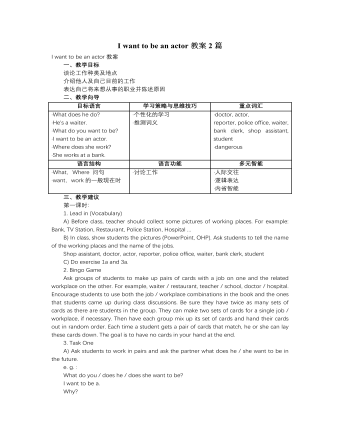
人教版新目标初中英语七年级下册I want to be an actor教案2篇
三、教学建议第一课时:1. Lead in (Vocabulary)A) Before class, teacher should collect some pictures of working places. For example: Bank, TV Station, Restaurant, Police Station, Hospital ...B) In class, show students the pictures (PowerPoint, OHP). Ask students to tell the name of the working places and the name of the jobs.Shop assistant, doctor, actor, reporter, police office, waiter, bank clerk, studentC) Do exercise 1a and 3a.2. Bingo GameAsk groups of students to make up pairs of cards with a job on one and the related workplace on the other. For example, waiter / restaurant, teacher / school, doctor / hospital. Encourage students to use both the job / workplace combinations in the book and the ones that students came up during class discussions. Be sure they have twice as many sets of cards as there are students in the group. They can make two sets of cards for a single job / workplace, if necessary. Then have each group mix up its set of cards and hand their cards out in random order. Each time a student gets a pair of cards that match, he or she can lay these cards down. The goal is to have no cards in your hand at the end.3. Task OneA) Ask students to work in pairs and ask the partner what does he / she want to be in the future.e. g. :What do you / does he / does she want to be?I want to be a.Why?Because it's (adj).B) Vocabulary: Section B, 1a4. Homework 1.2.
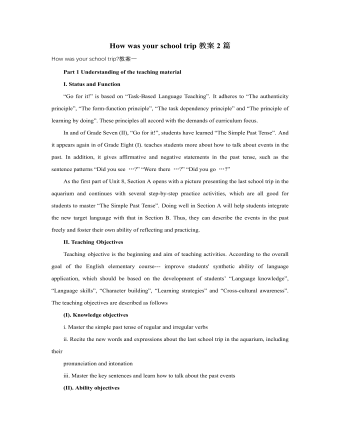
人教版新目标初中英语八年级上册How was your school trip教案2篇
“Go for it!” is based on “Task-Based Language Teaching”. It adheres to “The authenticity principle”, “The form-function principle”, “The task dependency principle” and “The principle of learning by doing”. These principles all accord with the demands of curriculum focus.In and of Grade Seven (II), “Go for it!”, students have learned “The Simple Past Tense”. And it appears again in of Grade Eight (I). teaches students more about how to talk about events in the past. In addition, it gives affirmative and negative statements in the past tense, such as the sentence patterns “Did you see …?” “Were there …?” “Did you go …?” As the first part of Unit 8, Section A opens with a picture presenting the last school trip in the aquarium and continues with several step-by-step practice activities, which are all good for students to master “The Simple Past Tense”. Doing well in Section A will help students integrate the new target language with that in Section B. Thus, they can describe the events in the past freely and foster their own ability of reflecting and practicing. II. Teaching ObjectivesTeaching objective is the beginning and aim of teaching activities. According to the overall goal of the English elementary course--- improve students' synthetic ability of language application, which should be based on the development of students’ “Language knowledge”, “Language skills”, “Character building”, “Learning strategies” and “Cross-cultural awareness”. The teaching objectives are described as follows(I). Knowledge objectivesi. Master the simple past tense of regular and irregular verbsii. Recite the new words and expressions about the last school trip in the aquarium, including their pronunciation and intonation
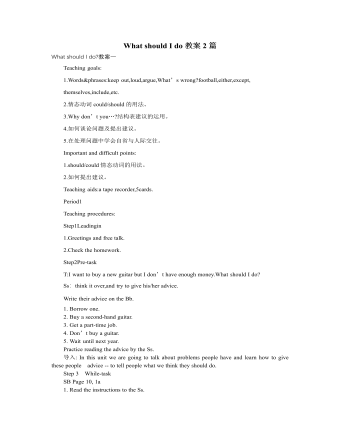
人教版新目标初中英语八年级下册What should I do教案2篇
说明:在帮Li Lei提建议的同时,教育学生如何学好英语。第三课时教学目标1. 语言目标:a) 词汇: Original, in style, haircut, the same as.b) 语言结构:My friend wears the same clothes and has the same haircut as I do.2. 能力目标:大多数学生能够谈论自己喜欢哪种服装,提高查找信息的能力。3. 情感目标:学会如何与朋友相处,要有自己对时尚的看法。教学重点掌握一些重要词汇。教学难点学会谈论问题,并能提出书面建议。◆教学突破首先针对Erin的问题,提出个人的建议,模仿2c部分的对话展开双人交际Pair-work;听老师诵读3a部分的信件,并找出LEFT OUT的问题所在;学生完成3b部分的内容,给Left Out提出书面的建议;学以口头形式提出自己目前存在的某个问题,讲给大家听,让同学们给自己提出一个建议,并作笔录;学生两、三个人分成一组,随意性地进行口语交际,谈论P14的第4部分的某个问题,相互交换意见。
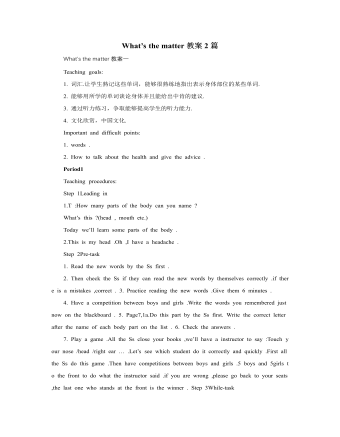
人教版新目标初中英语八年级上册What’s the matter教案2篇
She shouldn’t go to the party tonight.Step7. TaskT: You know, there are lots of problems in our life. If you are a doctor, please tell us how to solve the problem. I will divide you into 9 groups. Please work in groups. And then choose one of you to report your ideas.The following are the problems:I have a toothache.I am hungry. I have a sore throat.I am stressed out. I have a sore back.I am tired. I can’t sleep.I have a cold. I have a headache.Report: If you have a headache, you should go to bed early. You should see the doctor. You should eat some medicine. You shouldn’t wash your face with cold water.You shouldn’t sleep late.You shouldn’t swim.…..T encourages the students to give advice as much as possible.Homework:1. Chose one of the problems, and write down your advice2. Copy the new words这一步是用于热身的,同时也可以让他们复习一部分的表示人体部位的单词,扩充知识.学习语言的过程也是一个不断积累的过程,复习旧知识,增添新知识.通过小游戏,强化学生对Does she/he have…这个句子的运用能力.通过复习,自然的引到下面新知识的学习。充分利用表格,由句子到对话,再到文章,让学生循序渐进. 提高学生的综合语言运用能力,运用以前学过的知识来解决身边的问题.Period 5 (Section B 3a—3c, selfcheck)教学内容与分析:
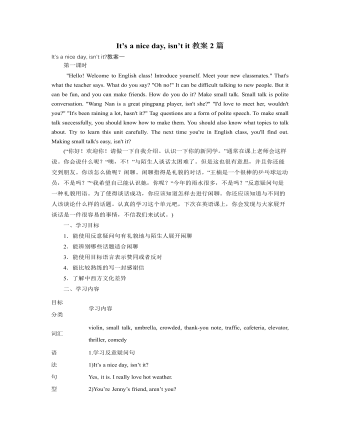
人教版新目标初中英语八年级下册It’s a nice day, isn’t it教案2篇
"Hello! Welcome to English class! Introduce yourself. Meet your new classmates." That's what the teacher says. What do you say? "Oh no!" It can be difficult talking to new people. But it can be fun, and you can make friends. How do you do it? Make small talk. Small talk is polite conversation. "Wang Nan is a great pingpang player, isn't she?" "I'd love to meet her, wouldn't you?" "It's been raining a lot, hasn't it?" Tag questions are a form of polite speech. To make small talk successfully, you should know how to make them. You should also know what topics to talk about. Try to learn this unit carefully. The next time you're in English class, you'll find out. Making small talk's easy, isn't it? (“你好!欢迎你!请做一下自我介绍。认识一下你的新同学。”通常在课上老师会这样说。你会说什么呢?“噢,不!”与陌生人谈话太困难了。但是这也很有意思,并且你还能交到朋友。你该怎么做呢?闲聊。闲聊指得是礼貌的对话。“王楠是一个很棒的乒乓球运动员,不是吗?”“我希望自己能认识她,你呢?“今年的雨水很多,不是吗?”反意疑问句是一种礼貌用语。为了使得谈话成功,你应该知道怎样去进行闲聊。你还应该知道与不同的人该谈论什么样的话题。认真的学习这个单元吧,下次在英语课上,你会发现与大家展开谈话是一件很容易的事情,不信我们来试试。)
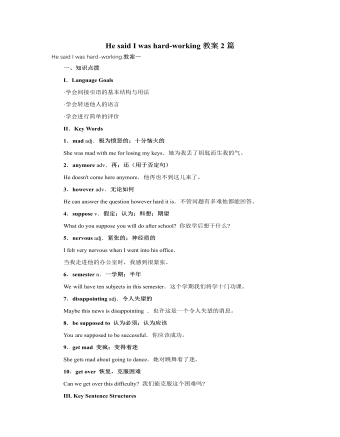
人教版新目标初中英语八年级下册He said I was hard-working教案2篇
This activity introduces some new vocabulary and provide oral practice using the target language.Task 1 . Ask four students to stand in front of the class, and the teacher asks them the following questions as a reporter.1.What are you going to do when you grow up?2.What are you going to do next week?3.What are going to do after school?The students will give different answers, then ask a good student to report what they said.I am going to e a doctor.What did she say?----------She said she was going to be a doctor.I am going to have a party on Friday night.What did he say?-------He said he was going to have a party on Friday night.I am going to do my homework.What did she say ?------ She said she was going to do her homework.I am going home after school.What did she say?-----She said she was going home after school.Say In this unit we are going to learn to use words like to report what someone said.Task 2. Read the instructions. Then ask a student to read the four questions. And write the words on the Bb. Explain what soap opera is.Task 3. Ask the students to Look at the pictures, point out the TV screens in the picture. Ask one girl to read what Marcia said.What did Marcia say? She said She said she was having a surprise party for Lana on Friday night. Repeat the other pictures in the same way.Activity3. Listen and number the pictures in activity 1a.
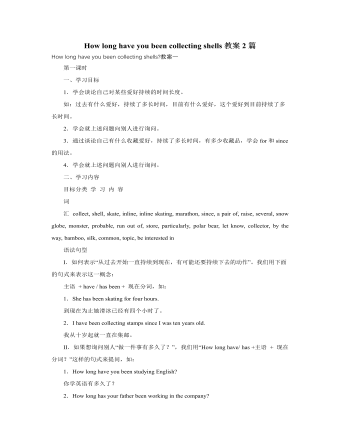
人教版新目标初中英语八年级下册How long have you been collecting shells教案2篇
Step Ⅱ Show the new words on the screen and teach the new words. Read the new words to students and ask them to repeat.Step Ⅲ 3aThis activity introduces new vocabulary and provides reading practice using the target language.In this activity first look at the four pictures.T: What can you see in the pictures?Ss: Four snow globes.T: Right. There are four snow globes in the pictures. And what are they?Ss: They are a monster, two polar bears, two penguins and a birthday cake.Write these words on the blackboard: snow globe; monster; polar bear; penguin and birthday cake. Read them to the class and ask students to repeat each one. Make sure students understand each word.Use a computer to show the E-mail message on the screen and read the message to students.Get students to read the e-mail on their own, and then draw lines connecting each snow globe and its description.Correct the answers.AnswersA line should connect each snow globe picture with the words that describe it in the letter.Step Ⅳ 3bThis activity provides writing practice using the target language.First review Activity 2a on Page 47.Then ask students to complete the message according to Activity 2a.Some partial sentences are given to students. Write about one person's collection.When students work, walk around the room checking the progress and offering help as needed.When they finish, ask some students to read their messages to the class.

人教版新目标初中英语九年级上册How do you study for a test教案2篇
内容提示本单元主要内容是学会利用verb十by/with gerund表示方式方法来讨论学习英语的策略,认识自己在学习方面的长处和不足。初步了解现在完成时的结构和用法。现在完成时由助动词have/has+动词的过去分词构成,主要表示过去发生的某一动作对现在仍有影响或造成的后果,常与already,yet,just,ever,never等副词连用。教学目标一、学习目标(Language Goal) 1. Talk about how to study . 学会讨论各种学习方法和策略。2. Find out your suitable learning methods. 找出适合自己的学习方法。 二、语言结构(Language Structures) 1. Verb + by with gerund by+动名词短语 表示“通过…途径,方法” 2. How questions have引导的特殊疑问句 三、目标语言(Target Language) 1. How do you study for tests ? 你是怎样准备考试的?Well , I study by working with my classmates. 哦,我和同学们一起学习。2. Have you ever studied with a group ? 你曾经参加过学习小组吗?Yes , I have . I’ve learned a lot that way . 是的,参加过。通过这种方式我学了许多。
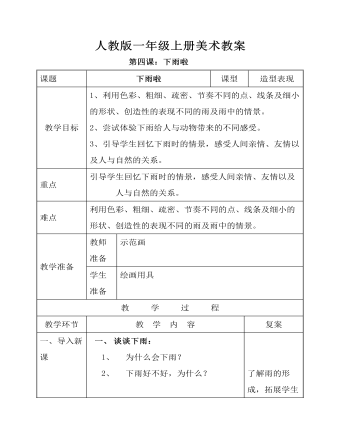
小学美术人教版一年级上册《第4课下雨啦》教案说课稿
1、利用色彩、粗细、疏密、节奏不同的点、线条及细小的形状、创造性的表现不同的雨及雨中的情景。2、尝试体验下雨给人与动物带来的不同感受。3、引导学生回忆下雨时的情景,感受人间亲情、友情以及人与自然的关系。
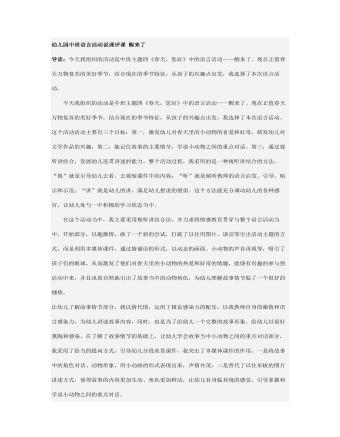
幼儿园中班语言活动说课评课 醒来了
今天我组织的活动是中班主题四《春天,您好》中的语言活动——醒来了。现在正值春天万物复苏的美好季节,结合现在的季节特征,从孩子的兴趣点出发,我选择了本次语言活动。 今天我组织的活动是中班主题四《春天,您好》中的语言活动——醒来了。现在正值春天万物复苏的美好季节,结合现在的季节特征,从孩子的兴趣点出发,我选择了本次语言活动。这个活动活动主要有三个目标:第一,激发幼儿对春天里的小动物的喜爱和好奇,萌发幼儿对文学作品的兴趣;第二,能记住故事的主要情节,学说小动物之间的重点对话。第三,通过视听讲结合,发展幼儿连贯讲述的能力。整个活动过程,我采用的是一种视听讲结合的方法,“视”就是引导幼儿去看、去观察课件中的内容;“听”就是倾听教师的语言启发、引导、暗示和示范;“讲”就是幼儿的讲,满足幼儿想说的愿望。这个方法能充分调动幼儿的各种感官,让幼儿处与一中积极的学习状态当中。
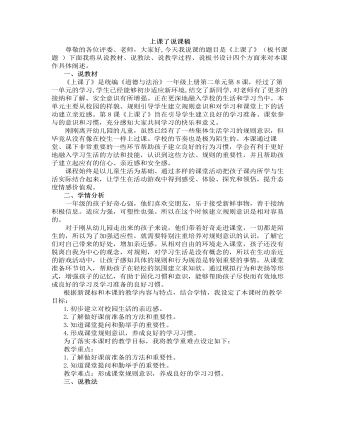
人教部编版道德与法制一年级上册上课了说课稿
1)上课时,同学们是怎么做的呢?窗外飞来几只小鸟,叽叽喳喳地叫着,同学们没有一个人看,这是为什么呢?2)如果上课不专心听讲,搞小动作,会造成什么后果呢?2.小结:上课玩东西,做小动作,会分散注意力,不能集中精神听老师讲课,既影响了自己的学习,有时还影响其他同学听课。当自己想玩时,一定要管住自己,不玩,不做小动作,时间长了,就能养成遵守课堂纪律的好习惯。过渡语:课上除了要专心听讲外,还应该怎样做呢?3.出示图三,讨论:(1)为什么想发言时要先举手?(2)如果自己举手老师没让发言,让其他同学发言时,应该怎么做?4、小结:想发言时要先举手,得到允许后再发言,如果老师让其他同学发言就认真听。随便说话,发言乱抢,谁也听不清,会影响自己和同学学习,影响老师讲课。同学们都举手发言,有秩序地讨论问题,大家才能学习好。过渡语:现在咱们知道应该怎样上课了,下面老师想请你们当小老师,来看看下面这些同学做得怎么样,怎样帮助他们? (出示图片)
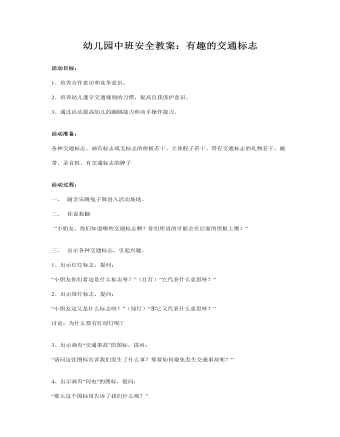
幼儿园中班安全教案:有趣的交通标志
活动准备:各种交通标志、画有标志或无标志的拼板若干、立体骰子若干、带有交通标志的礼物若干、磁带、录音机、有交通标志的牌子 活动过程: 一、 随音乐跳兔子舞进入活动场地。二、 你说我翻 “小朋友,你们知道哪些交通标志啊?你们所说的可能会在后面的黑板上哦!”

北师大初中七年级数学上册数据的收集教案2
1. 小明的脚长23.6厘米,鞋号应是 号。2.小亮的脚长25.1厘米,鞋号应是 号。3.小王选了25号鞋,那么他的脚长约是大于等于 厘米且小于 厘米。小结:刚才同学们都体会到了分组编码使原来繁多,无叙的数据简化、有序。因此分组、编码是整理数据的一种重要的方法,在工商业、科研等活动中有广泛的应用(四)反馈练习课内练习以下是某校七年级南,女生各10名右眼裸视的检测结果:0.2,0.5,0.7(女),1.0,0.3(女),1.2(女),1.5,1.2,1.5(女),0.4(女),1.5,1.1,1.2(女),0.8(女),1.5(女),0.6(女),1.0(女),0.8,1.5,1.2(1)这组数据是用什么方法获得的?(2)学生右眼视力跟性别有关吗?为了回答这个问题,你将怎样处理这组数据?你的结论是什么?(五). 归纳小结,体味数学快乐通过本节课的学习,你有那些收获?(课堂小结交给学生)数据收集的方法:直接观察、测量、调查、实验、查阅文献资料、使用互连网等。整理数据的方法:分类、排序、分组编码等。(学生可能还会指出鞋码和脚长之间的关系等)
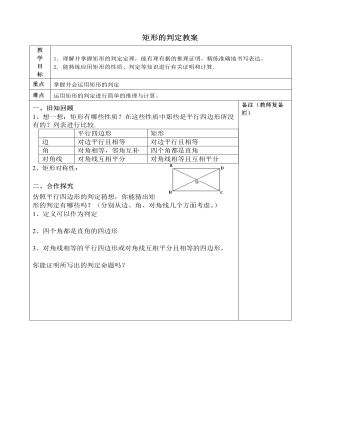
北师大初中数学九年级上册矩形的判定2教案
2.已知:如图 ,在△ABC中,∠C=90°, CD为中线,延长CD到点E,使得 DE=CD.连结AE,BE,则四边形ACBE为矩形吗?说明理由。答案:四边形ACBE是矩形.因为CD是Rt△ACB斜边上的中线,所以DA=DC=DB,又因为DE=CD,所以DA=DC=DB=DE,所以四边形ABCD是矩形(对角线相等且互相平分的四边形是矩形)。四、课堂检测:1.下列说法正确的是( )A.有一组对角是直角的四边形一定是矩形 B.有一组邻角是直角的四边形一定是矩形C.对角线互相平分的四边形是矩形 D.对角互补的平行四边形是矩形2. 矩形各角平分线围成的四边形是( )A.平行四边形 B.矩形 C.菱形 D.正方形3. 下列判定矩形的说法是否正确(1)有一个角是直角的四边形是矩形 ( )(2)四个角都是直角的四边形是矩形 ( )(3)四个角都相等的四边形是矩形 ( ) (4)对角线相等的四边形是矩形 ( )(5)对角线相等且互相垂直的四边形是矩形 ( )(6)对角线相等且互相平分的四边形是矩形 ( )4. 在四边形ABCD中,AB=DC,AD=BC.请再添加一个条件,使四边形ABCD是矩形.你添加的条件是 .(写出一种即可)
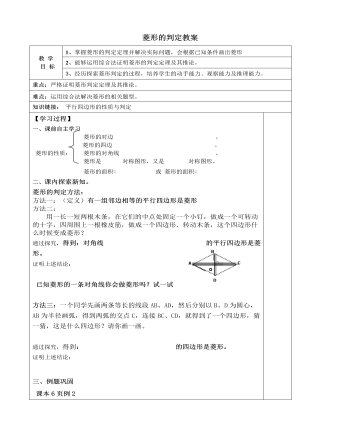
北师大初中数学九年级上册菱形的判定2教案
方法三:一个同学先画两条等长的线段AB、AD,然后分别以B、D为圆心,AB为半径画弧,得到两弧的交点C,连接BC、CD,就得到了一个四边形,猜一猜,这是什么四边形?请你画一画。通过探究,得到: 的四边形是菱形。证明上述结论:三、例题巩固课本6页例2 四、课堂检测1、下列判别错误的是( )A.对角线互相垂直,平分的四边形是菱形. B、对角线互相垂直的平行四边形是菱形C.有一条对角线平分一组对角的四边形是菱形. D.邻边相等的平行四边形是菱形.2、下列条件中,可以判定一个四边形是菱形的是( )A.两条对角线相等 B.两条对角线互相垂直C.两条对角线相等且垂直 D.两条对角线互相垂直平分3、要判断一个四边形是菱形,可以首先判断它是一个平行四边形,然后再判定这个四边形的一组__________或两条对角线__________.4、已知:如图 ABCD的对角线AC的垂直平分线与边AD、BC分别交于E、F求证:四边形AFCE是菱形
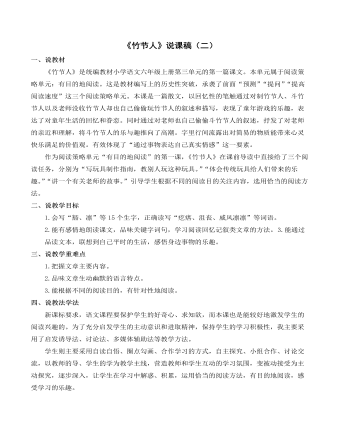
部编人教版六年级上册《竹节人》说课稿(二)
3.再读课文,划分段落结构。说说本文可以分为哪几个部分,简要概括各部分的主要内容。第一部分(1--2段):概述“我们”小时候喜欢玩自己做的竹节人。 第二部分(3--7段):写制作竹节人的过程。 第三部分(8--19段):主要写斗竹节人的过程与乐趣,表现了孩子们对竹节人游戏的喜爱。 第四部分(20--29段):主要写老师没收了竹节人,却也偷偷在玩竹节人的趣事。 尊重学生的初始阅读感受,引导学生有意识地根据课前导语部分的阅读任务进行有目的地阅读,在自主探究中发现阅读方法。接着小组交流:根据不同的阅读目的,是怎么阅读课文的。让学生交流、丰富自己的阅读方法,同时教师适时引导,让学生学会积累、运用恰当的阅读方法。在对阅读任务的把握上,感知课文内容,理清文章层次,这样学生对文章内容结构的划分就水到渠成了。
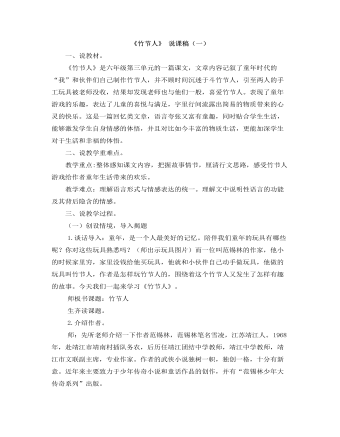
部编人教版六年级上册《竹节人》说课稿(一)
一、说教材。《竹节人》是六年级第三单元的一篇课文,文章内容记叙了童年时代的“我”和伙伴们自己制作竹节人,并不顾时间沉迷于斗竹节人,引至两人的手工玩具被老师没收,结果却发现老师也与他们一般,喜爱竹节人。表现了童年游戏的乐趣,表达了儿童的喜悦与满足,字里行间流露出简易的物质带来的心灵的快乐。这是一篇回忆类文章,语言夸张又富有童趣,同时贴合学生生活,能够激发学生自身情感的体悟,并且对比如今丰富的物质生活,更能加深学生对于生活和幸福的体悟。二、说教学重难点。教学重点:整体感知课文内容,把握故事情节,厘清行文思路,感受竹节人游戏给作者童年生活带来的欢乐。教学难点:理解语言形式与情感表达的统一。理解文中说明性语言的功能及其背后隐含的情感。
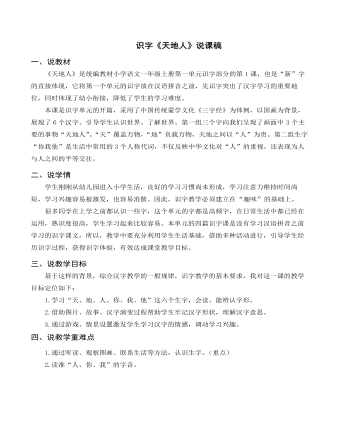
部编人教版一年级上册识字《天地人》说课稿
三、说教学目标基于这样的背景,综合汉字教学的一般规律,识字教学的基本要求,我对这一课的教学目标定位如下:1.学习“天、地、人、你、我、他”这六个生字,会读、能辨认字形。2.借助图片、故事、汉字演变过程帮助学生牢记汉字形状,理解汉字意思。3.通过游戏、情景设置激发学生学习汉字的情感,调动学习兴趣。四、说教学重难点1.通过听读、观察图画、联系生活等方法,认识生字。(重点)2.读准“人、你、我”的字音。五、说教法学法为了突出重点,化解难点,完成教学目标,选择行之有效的教学方法十分关键。根据新课标的具体要求,结合本节课的特点,我主要采用游戏激趣法、图文结合,利用多媒体课件调动学生学习的积极性。学生则通过游戏,联系生活实际,小组合作等方法学习6个生字。
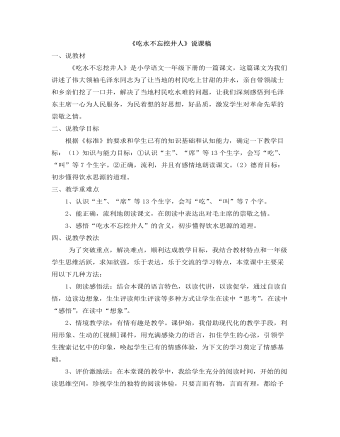
部编人教版一年级下册《吃水不忘挖井人》说课稿
一、说教材《吃水不忘挖井人》是小学语文一年级下册的一篇课文,这篇课文为我们讲述了伟大领袖毛泽东同志为了让当地的村民吃上甘甜的井水,亲自带领战士和乡亲们挖了一口井,解决了当地村民吃水难的问题,让我们深刻感悟到毛泽东主席一心为人民服务,为民着想的好思想,好品质,激发学生对革命先辈的崇敬之情。二、说教学目标根据《标准》的要求和学生已有的知识基础和认知能力,确定一下教学目标:(1)知识与能力目标:①认识“主”、“席”等13个生字,会写“吃”、“叫”等7个生字。②正确,流利,并且有感情地朗读课文。(2)德育目标:初步懂得饮水思源的道理。

